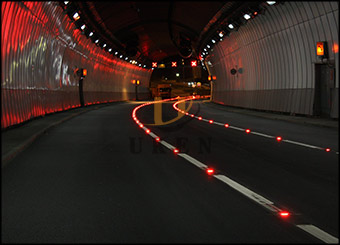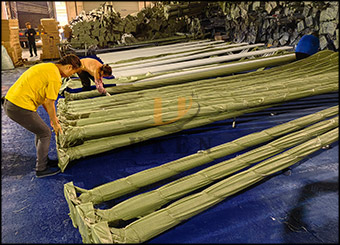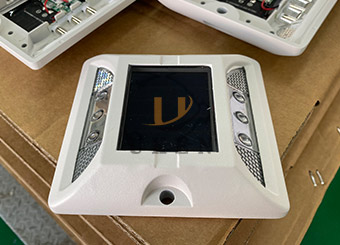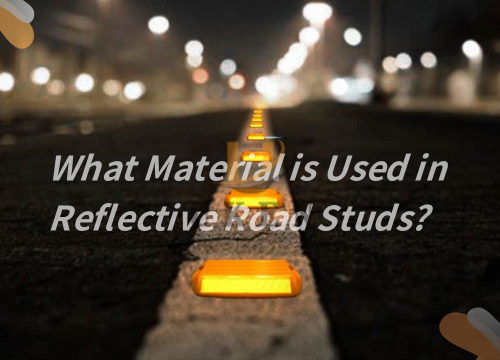In the huge system of road safety facilities, aluminium road studs with a series of unique and excellent characteristics, steadily occupies an important position, to protect traffic safety plays an irreplaceable role. Next, let’s explore the mystery of the characteristics of aluminium road nails.
Aluminium, as a metal with abundant reserves on earth and widely used, gives aluminium road studs many inherent advantages. One of its most notable features is its light weight, a feature that greatly facilitates the installation and maintenance of studs. They can be easily handled by crews, which reduces labour intensity and improves installation efficiency in large-scale road laying projects. For example, in the construction of a road several kilometres long, the lightweight nature of aluminium spikes allowed the team to complete the spikes in a shorter period of time, reducing prolonged disruption to traffic.
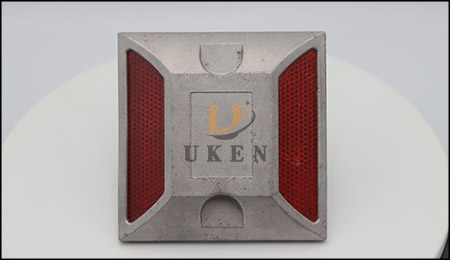
At the same time, aluminium is strong enough to withstand the frequent crushing of vehicles day after day, year after year. Under normal traffic flow, aluminium road studs are able to maintain structural integrity and are not susceptible to deformation, rupture and other conditions, providing a long-term stable road marking. Moreover, aluminium’s good plasticity allows road studs to be shaped into a variety of shapes and sizes to meet the special needs of different road scenarios, whether it’s a large, eye-catching road stud on a wide trunk road, or a small, compact stud in a narrow alley, aluminium can be perfectly adapted to the situation.
Aluminium alloys are widely used in the production process to further exploit the potential of aluminium and enhance the performance of spikes. By adding copper, magnesium, zinc and other alloying elements to pure aluminium, the performance of aluminium alloys is strengthened in all aspects. Take magnesium-containing aluminium alloy as an example, its corrosion resistance has been significantly improved, in the humid and rainy southern region, or high salt content of the coastal zone, can effectively resist the rain, seawater fog and corrosive substances in the air erosion. In these environments, ordinary materials may appear in a short period of time, rust, damage phenomenon, while containing magnesium aluminium alloy road nails can remain in good condition, continue to play the function of marking, greatly reducing the frequency of replacement, reduce maintenance costs.

The addition of copper elements can enhance the hardness and strength of aluminium alloy, so that when facing the frequent crushing of heavy vehicles, the road spike can still hold its position without deformation, excessive wear and tear and other problems. This kind of aluminium road studs after alloying treatment, in the highway and other heavy vehicle traffic frequent road performance, for the protection of high-speed vehicle safety to provide a solid guarantee.
Aluminium road studs common shapes are round and square, each shape contains a unique design ideas. Round studs have rounded and smooth edges, and the contact area is relatively even when the vehicle tyre is crushed, effectively reducing the wear and tear on the tyre. In daily traffic, frequent friction between tyres and studs may lead to abnormal wear on the tyre surface, affecting the life of the tyre and driving safety, and round studs are a good way to avoid this problem. Moreover, round road studs are subject to vehicle pressure in all directions, the force can be evenly dispersed, their own structure is not easy to damage, prolonging the use of studs cycle.
Square studs, with its unique geometry, excellent performance in terms of stability. In some of the spikes positioning accuracy requirements are extremely high in the region, such as road intersections, vehicle travelling in a complex direction, the need for clear and unambiguous signs to guide. Square spikes can accurately delineate lanes, guide vehicles to turn and go straight in an orderly manner, and their stable structure ensures that they remain fixed under the impact of complex traffic flows, providing drivers with reliable road guidance.
Sizes to suit various needs
Aluminium spikes are available in a wide range of sizes, taking into account the differences in road types and usage scenarios. In the non-motorised road or the internal road of the district, the traffic flow is relatively small, and the vehicle types are mainly bicycles, small electric vehicles and family cars. At this point, the smaller size of the road spike will be able to meet the needs of its lightweight features to facilitate the installation, will not cause excessive pressure on the relatively fragile road surface, and at the same time can clearly mark the road boundaries, to protect the non-motorised vehicles and pedestrians safe travel.
Large aluminium road studs are preferred on roads where heavy vehicles frequently travel, such as motorways and heavy freight corridors. These spikes usually have a larger bottom area and higher compressive strength, able to withstand tens of tonnes of trucks repeatedly crushed. The large size design increases the contact area between the spike and the road surface, disperses the heavy pressure of the vehicle, and ensures that the spike is firmly embedded in the road surface without displacement or loosening, providing clear and accurate road markings for heavy vehicles travelling at high speeds, and guaranteeing the safety and smoothness of long-distance transport.
Aluminium road studs have a delicate internal structure, mainly composed of reflective elements and fixed structures. The reflective element is the heart of the spike’s function at night or in low visibility. Common reflective elements include reflective glass beads and reflective film. When the vehicle lights hit the road studs, reflective glass beads use the principle of refraction and reflection of light to converge and reflect the light back to the driver’s line of sight, so that the road studs in the dark as twinkling stars, particularly eye-catching. The reflective film, on the other hand, realises efficient retro-reflection through the micro-prism structure, which greatly enhances the visibility distance of the road studs, so that drivers can clearly identify the location of the studs in advance and make the correct driving judgement even under the illumination of high beams.
The fixing structure is responsible for firmly attaching the spike to the road surface to ensure that it does not fall off in various environments and traffic conditions. Common fixing methods include pre-embedded and adhesive. Pre-embedded type is suitable for concrete pavement construction, in the process of pouring pavement, the road spike will be pre-buried, when the concrete is solidified, the road spike and the pavement tightly combined into one, excellent stability. Paste type is mostly used in asphalt pavement, through the special glue will be road nails pasted on the road surface, easy and fast operation, and can ensure that the road nails in the normal traffic load under the degree of solidity, the two fixing methods according to the pavement material and the use of the scene flexibility to choose from, and together to ensure that the road nails play a role in the stability of the road nails.
The reflective performance of aluminium road studs is based on the rigorous optical reflection law. When the light from the vehicle headlight hits the surface of the road stud, the reflective material starts to play a role. Taking a reflective glass bead as an example, the light enters the glass bead, is refracted within it, and then total reflection occurs at the interface between the glass bead and the air, where the light is eventually reflected back to the driver’s eyes in a direction nearly parallel to the incident light. This reflection process is like lighting up a pointer for the driver in the darkness, clearly outlining the road contours and lane boundaries.
The microprism structure of the reflective film is even more subtle, consisting of countless tiny right-angled prisms. When light hits the micro-prisms, it is reflected many times inside the prisms, and finally reflected back at an angle of almost 180 degrees. This efficient retro-reflection makes the road studs at night or in fog, heavy rain and other inclement weather, can still provide drivers with clear visual signs, greatly improving driving safety.
In order to ensure that aluminium road studs have excellent and long-lasting reflective properties, the selection of reflective materials during the production process is extremely stringent. High-intensity reflective film is the first choice for many high-end spikes. Not only does this reflective film have a very high reflective strength, clearly reflecting vehicle lights at night and providing a long-distance warning to drivers, but it also has excellent durability. In the complex outdoor environment, long-term exposure to ultraviolet radiation, rain, wind and sand erosion, but still be able to maintain a good reflective effect. In some important highway curves, steep slopes and other accident-prone road sections, the use of aluminium road studs made of high-intensity reflective film can effectively reduce the incidence of accidents and protect road traffic safety.
For some of the more sensitive to the cost, but still need to ensure a certain reflective effect of the road project, engineering-grade reflective film is the right choice. It meets the basic reflective needs while having a better cost performance, and is widely used in ordinary highways, urban secondary roads and other scenarios to provide reliable road marking services for the majority of road users.
The installation angle of road studs is one of the key factors affecting the reflective effect. Only when the reflective surface is perpendicular to the direction of vehicle travelling, it can reflect the light to the maximum extent and provide the best visual effect for drivers. In the actual installation process, the construction personnel need to use professional measuring tools to accurately adjust the installation angle of the road studs to ensure that each stud can play the best reflective performance.
The cleanliness of the surface of the spike should not be neglected. In daily use, the surface of the spike is easy to adhere to dust, oil, debris, etc., these pollutants will hinder the reflection of light, reducing the reflective effect. Therefore, regular cleaning and maintenance of road studs is essential. Road maintenance departments can arrange for regular inspections, the use of professional cleaning equipment on the road spike cleaning, to maintain its surface clean, to ensure stable reflective performance.
Road surface conditions will also have an indirect impact on the reflective effect of road studs. In the uneven road surface, road studs may be crushed by vehicles and tilted, resulting in reflective angle change; waterlogged roads will form a water film, weakening the light reflection. To address these issues, in the road construction and maintenance process, should ensure that the road surface smoothness, timely repair of damaged road surface; for easy to waterlogged road sections, can be optimised by optimising the drainage system, reduce the road surface water, to ensure that the reflective effect of the road studs are not affected, and continue to provide clear and accurate guidance for road users.

